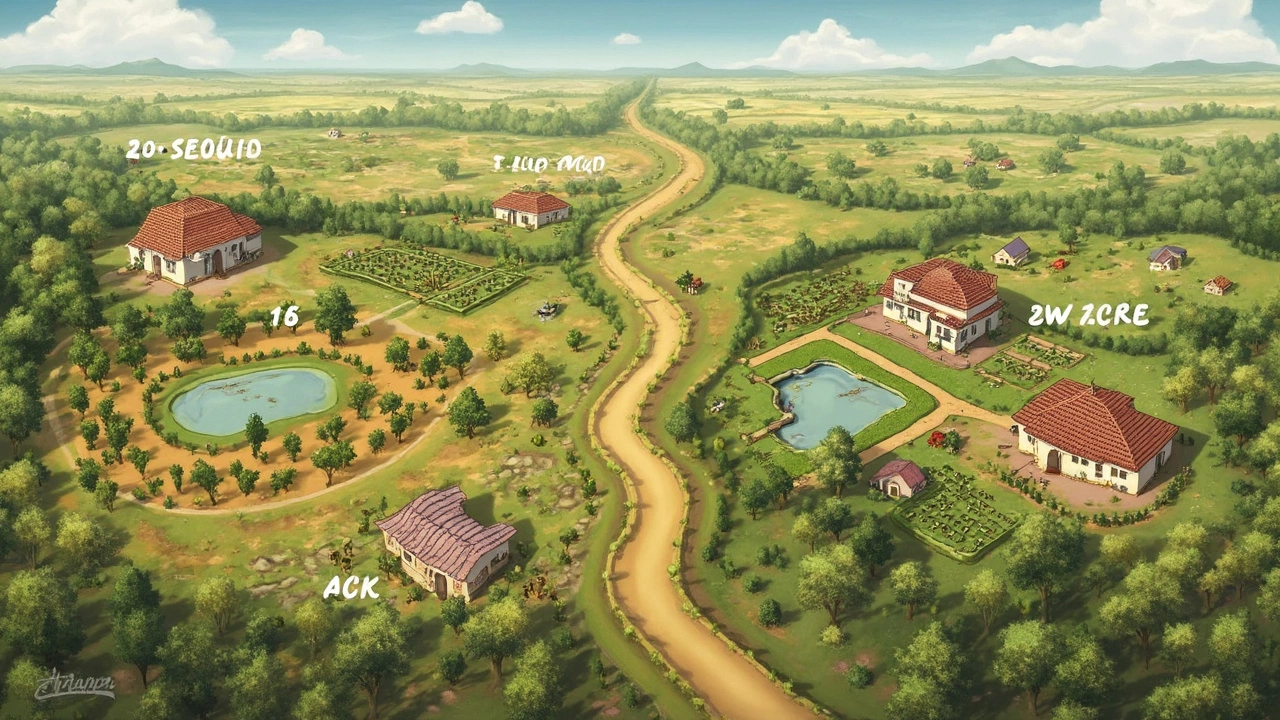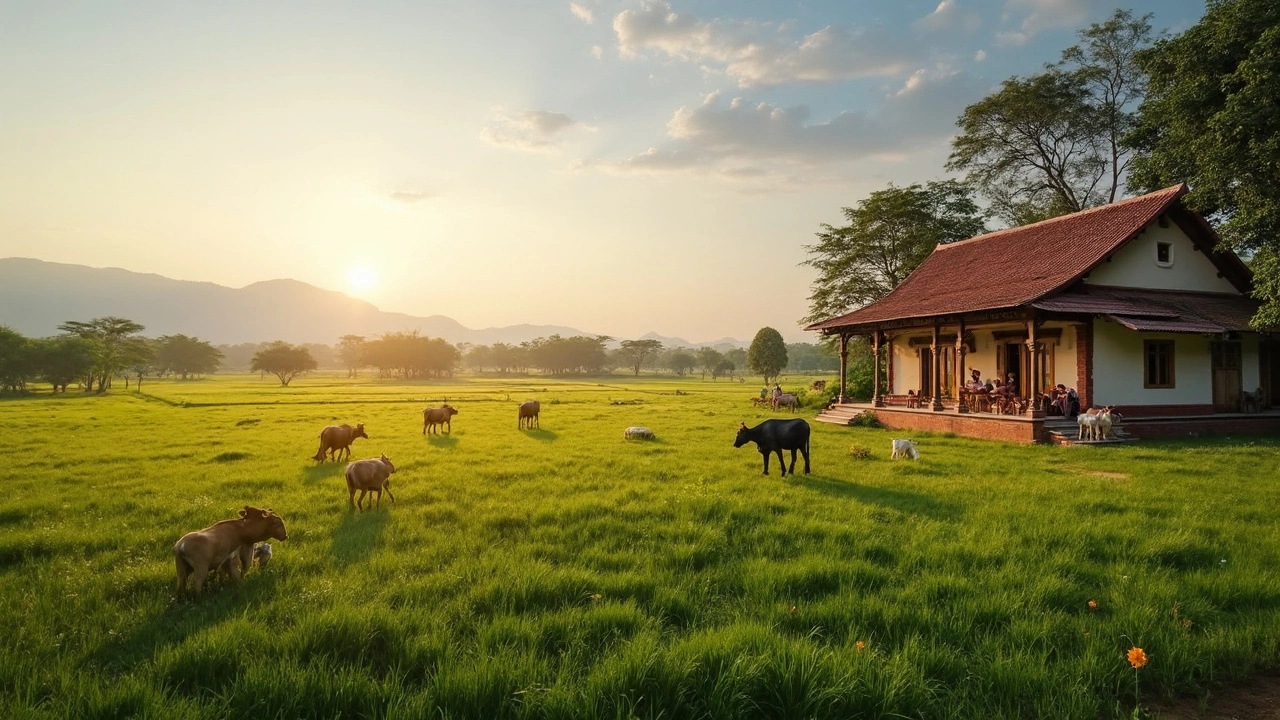Picture this: You’ve found a property listing for a 10-acre parcel in the countryside, and the word “ranch” pops up in the description. So, is 10 acres really enough to call your place a ranch? People toss the word around pretty loosely, but the answer isn’t as clear-cut as you might think.
Most folks imagine a ranch as this massive, open piece of land with horses, cattle, and maybe a giant fancy gate. But honestly, there’s no official rule about where ranch territory begins or ends. Ten acres could absolutely work for some people—especially if your goal isn’t to run hundreds of cattle but to enjoy space, privacy, and maybe some hobby animals.
Here’s the thing: what matters is how you want to use the land. Are you thinking of raising a few goats, keeping chickens, or just looking for a slice of quiet with room to spread out? Ten acres gives you a lot more breathing room than you’ll ever find in suburbia. If your dream is a small ranch lifestyle or a villa surrounded by open space, you don’t need a sprawling estate to make it happen.
- What Actually Counts as a Ranch?
- 10 Acres: How Big Is It Really?
- What Can You Do with 10 Acres?
- Comparing Ranches, Farms, and Villas
- Tips for Buying 10 Acres as a Ranch
What Actually Counts as a Ranch?
Here’s the truth: there’s no government rulebook that officially says how many acres you need to call your property a ranch. In the U.S., the definition actually depends more on what you do with the land, not just how much you have. A ranch is usually a property where people raise livestock, like cows, sheep, goats, or horses. You might think of the huge cattle spreads out West, but smaller ranches are all over, even in states where land is scarcer and more expensive.
Real estate listings love using the word “ranch” to describe everything from a fenced-in 5-acres with a barn, to thousand-acre operations. But when banks, agricultural experts, or state agencies talk about ranches, they focus way more on use rather than acreage. Here’s a breakdown of what actually matters:
- 10 acres is actually common for “hobby ranches” or “ranchettes” where folks keep a few animals and enjoy extra space, but aren’t running a full-scale business.
- In Texas, the country’s most ranch-obsessed state, the average ranch is over 500 acres, but you’ll find plenty between 10 and 50 acres, especially near cities.
- Some USDA loan programs consider anything over 5 acres with livestock-raising activity as a ranch for financing purposes.
Check out just how often land size and actual use line up in ranching:
| Type | Typical Acreage | Main Use |
|---|---|---|
| Hobby Ranch (Ranchette) | 5-50 acres | Few animals, private retreat |
| Working Ranch | 50-1000+ acres | Livestock business, agriculture |
| Villa with Land | 1-20 acres | Lifestyle, personal use |
If you’re picturing little kids feeding goats, gathering fresh eggs, or a couple of horses grazing, a 10-acre property covers all of that comfortably. The term "ranch" mostly comes down to how you want to live and what you plan to do with the space—so if you’re buying for your own escape and some hobby farming, no one’s going to stop you from calling it a ranch.
10 Acres: How Big Is It Really?
If you’ve never stood on a ten-acre plot, it’s tough to picture just how much land that actually is. In simple terms, one acre is about the size of a football field (without the end zones). So, imagine ten of those fields lined up together, side by side—that’s your ten-acre experience.
To put it into numbers, one acre equals 43,560 square feet. That means ten acres rack up 435,600 square feet. Here’s a quick breakdown for comparison:
| Land Size | Square Feet | Comparison |
|---|---|---|
| 1 Acre | 43,560 | About 1 football field |
| 5 Acres | 217,800 | 5 football fields |
| 10 Acres | 435,600 | 10 football fields |
That’s a lot of open space, enough to walk for several minutes before you hit a fence. Still, next to those massive ranches in Texas or Montana stretching out over thousands of acres, 10 acres looks small. But for growing your own food, having animals, or just escaping city noise, it’s plenty.
Here’s what you can fit on ten acres if you plan smart:
- A spacious villa or two with a pool, plus a big garden
- A few barns or sheds
- Room for a small pasture, riding arena, or orchard
- Walking trails, play area, and still lots of privacy
In places where land is expensive, owning ten acres is pretty rare. You’ll notice a real difference in your daily life compared to tiny city plots. If you’re buying for the ranch experience—or just want room to breathe—10 acres is nothing to sneeze at.

What Can You Do with 10 Acres?
Ten acres gives you a ton of options. It all depends on your interests and what kind of lifestyle you want. For a lot of people, 10 acres is the sweet spot—enough to feel private and spacious but still manageable to maintain yourself.
If you’re thinking livestock, 10 acres can support a small herd of goats, a couple of horses, or a handful of cows without much trouble. You’ll have plenty of space for chickens, bees, or maybe even some sheep if you’re up for a little adventure. For animals like horses or cows, one to two acres per animal is a good starting point, especially if you want them to graze on pasture.
Gardening? Go wild. On 10 acres, you could plant a huge vegetable garden, add a few fruit trees, and still have lawn left over. Some folks use a few of those acres for cash crops, like lavender or berries, while keeping the rest as open space. If you like the idea of growing your own food, you have room for greenhouses, raised beds, even a small orchard.
When it comes to building, 10 acres gives you room to sprawl. You can easily fit a villa, a guesthouse, a big barn, and a couple of sheds or workshops. The distance from neighbors is a big perk—think quiet evenings and no one looking over your fence. And if you dream of a swimming pool, playground, or a private trail for ATVs or dirt bikes, all that’s totally doable.
- Plant a big vegetable patch, orchard, or vineyard
- Keep a mix of animals—goats, chickens, sheep, or cows
- Build multiple structures like guesthouses or barns
- Set up a private sports court or playground
- Use the land as a buffer for privacy and noise reduction
Bottom line, you get flexibility. Whether you're aiming for a hobby farm, a peaceful villa, or a home business spot, 10 acres offers enough space to get creative and live how you want, without the overwhelming upkeep of a huge spread.
Comparing Ranches, Farms, and Villas
Ranches, farms, and villas sound similar, but they’re actually pretty different when you get into the details. Here’s how they break down and what you need to know before shopping for your ideal property.
At a basic level, a ranch is usually all about livestock—think cattle, horses, or sheep. If it’s used mainly for grazing and raising animals, it’s a ranch, even if it’s just 10 acres. You don’t need hundreds of cows or rolling plains to use that word, especially in the U.S., where the definition can be pretty flexible.
Farms, on the other hand, are focused more on crops or a mix of crops and animals. Picture cornfields, vegetable gardens, or maybe a few dairy cows. You’ll find lots of farms that are way smaller than your typical image of a ranch. There are plenty of 5- and 10-acre farms out there growing specialty produce for local markets.
Now, villas lean more toward comfort and lifestyle than traditional agricultural work. They’re designed for living well—think open layouts, pools, and outdoor spaces. A villa on 10 acres gives you tons of privacy, room for gardens, maybe a few chickens or a horse, but not typically full-scale farming or ranching. These days, some people blend the styles—a villa with a small vineyard or garden counts as a "lifestyle property."
To make it simple, check out this comparison:
| Property Type | Main Use | Typical Features | Common Size (but not a rule) |
|---|---|---|---|
| Ranch | Livestock (cattle, horses, sheep) | Grazing land, barns, sometimes a main house | 10-10,000+ acres |
| Farm | Crops and/or some livestock | Fields, gardens, sheds, farmhouse | 5-1,000+ acres |
| Villa | Residential, recreation, lifestyle | Luxury home, landscaping, pool, gardens | Any size (usually 1-20 acres) |
So if you’re eyeing that 10 acres for sale, decide first what you want to do with it. You can create a mini ranch, a decent-sized hobby farm, or a private villa with space for everything from parties to a backyard orchard. Most listings will call it whatever fits the main use or the vibe they want to sell.
- Want animals? Call it a ranch.
- Love to garden and grow your food? It’s a farm.
- Just want privacy, space, and a killer house? That’s a villa.
If you ever see ads mixing the words, it’s not a trick—it just means you get options. Focus on your needs, not just the label.

Tips for Buying 10 Acres as a Ranch
So, you’re eyeing ten acres and wondering how to make sure it really works as a ranch. Before you sign anything, there are a few things you have to check out to get the most out of your land.
First, zoning laws are a big deal. Some areas let you keep livestock and build whatever you want, but others have strict rules. Double-check what’s actually allowed. According to the National Association of Realtors, “Always verify local zoning ordinances before buying rural land. Nothing stalls your dream faster than unexpected restrictions.”
"Land use regulations can make or break your plans, so don’t skip this step." — National Association of Realtors
Water access is another huge factor. Ten acres without enough water is a hassle, especially if you want animals or a garden. Check if you can dig a well or if there’s city water. For rural land, well drilling can get expensive fast.
Speaking of costs, don’t forget these when budgeting for your 10 acres:
- Fencing (for animals or privacy)
- Drilling a well or connecting to water lines
- Access roads or driveways
- Property taxes (these go up if the land is improved)
- Electricity and septic system installation
Here’s some quick real-world data for buyers in 2025:
| Expense | Low Estimate (USD) | High Estimate (USD) |
|---|---|---|
| Fencing 10 Acres | $8,000 | $20,000 |
| Drilling a Well | $6,000 | $15,000 |
| Septic System | $4,500 | $12,000 |
| Running Electricity | $4,000 | $10,000 |
Don’t forget to walk the entire property. Wet patches, steep hills, or weird easements can mess with your plans. Get a survey so you know exactly what you own.
If you’re new to country life, chat with the neighbors. They usually know the local quirks, like if flooding is an issue, or if the soil is rocky. Sometimes, you can even ask them about good contractors or places to buy feed if you end up running livestock later.
Finally, be realistic about what you want versus what the land offers. Ten acres can support a lot, but it can fill up faster than you think if you add barns, paddocks, or even just a big garden and villa. Spend some time on paper plotting out your dream setup before you commit.
